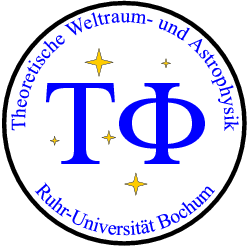Euler equations
In the literature a variety of (multi-) fluid (Euler-) equations with different extensions is used ( Pogorelov et al. 2009, Bouquet et al. 2000, <Fahr et al. 2000, Jun et al. 1994, Downes & Drury 2014).
The set of Euler equations, the continuity -, momentum -, and energy
equation can be combined into:
\begin{eqnarray}
\label{eq:1}
\del \begin{bmatrix}
\rho_{j} \\
\rho_{j} \vec{u}_{j} + \mathcal{P}_{1} \vec{F}_{rad} \\
E_{j} + \mathcal{P}_{2} E_{rad}\\ \vec{B}
\end{bmatrix}
+\div \begin{bmatrix}
\rho_{j} \vec{u}_{j} \\
\rho_{j} \vec{u}_{j}\otimes\vec{u}_{j} + P_{j} \widehat{I} +
\mathcal{P}_{3} \vec{F}_{rad} - \dfrac{\vec{B}\otimes\vec{B}}{4\pi}\\[0.25cm]
(E_{j} + P_{j} )\vec{u}_{j} + \mathcal{P}_{4} \vec{F}_{rad}
-\dfrac{\vec{B}(\vec{B}\cdot\vec{u_{j}})}{4\pi} \\
\vec{u}_{j}\otimes\vec{B}-\vec{B}\otimes\vec{u}_{j}
\end{bmatrix} =\\
\begin{bmatrix} 0 \\ \rho_{j} \vec{F} + \div \widehat{\sigma} -
\vec{\nabla} P_{CR}
\\
\rho_{j} \vec{u}_{j}\cdot\vec{F} + \div (\vec{u}_{j}\cdot\widehat{\sigma}) -
\div \vec{Q} - R_{L} -\vec{u}_{j}\cdot\vec{\nabla} P_{CR}\\0\end{bmatrix}
+ \begin{bmatrix} S_{j}^{c} \\ \vec{S}_{j}^{m}\\S_{j}^{e}\\\vec{A}\end{bmatrix}
\end{eqnarray}
where the left-hand side is written in a conservative form.
\(\vec{u}_{j}, \rho_{j}, E_{j}, P_{j}\) are the fluid velocity, mass density,
total energy density and pressure of species \(j\), \(\widehat{I}\) is the
unit tensor, \(\widehat{\sigma}\) the viscosity/stress tensor, \(\vec{F}\)
is an external force per unit mass and volume , \(\vec{Q}\) is the heat
flow, \(S_{j}^{r}\) are sources and sinks caused by charging processes
in the continuity and energy equation \(r\in\{c,e\}\) and
\(\vec{S_{j}^{m}}\) those of the momentum equation. \(R_{L}\) is a
cooling function. The parameters with the subscript \(_{rad}\) describe
the momentum \(\vec{F}_{rad}\) and energy \(E_{rad}\) coupling to the
radiation transport, while \(P_{CR}\) that to cosmic rays. The
\(\mathcal{P}_{k}, k\in\{1,2,3,4\}\) are constants. Finally,
\(\vec{A}_{j}\) describes the ambipolar diffusion between the neutrals
and the ions.
\(\otimes\) denotes the dyadic product.
For astrosphere scenarios a single fluid apporach is used, in which only protons \(j=p\) are modeld or an average mass is used. The heat flow \(\vec{Q}\), viscosity/stress tensor\(\widehat{\sigma}\). external forces \(\vec{F}\), radiation effectcs, and ambipolar diffusion are neglected, except a cooling function \(R_{L}\) in the energy equation.
Thus the Euler equations reduce to
\begin{eqnarray} \label{eq:2} \del \begin{bmatrix} \rho \\ \rho \vec{u} \\ E \\ \vec{B} \end{bmatrix} +\div \begin{bmatrix} \rho \vec{u} \\ \rho \vec{u}\otimes\vec{u} + P \widehat{I} + - \dfrac{\vec{B}\otimes\vec{B}}{4\pi}\\ (E + P )\vec{u} -\dfrac{\vec{B}(\vec{B}\cdot\vec{u})}{4\pi} \\ \vec{u}\otimes\vec{B}-\vec{B}\otimes\vec{u} \end{bmatrix} = \begin{bmatrix} 0 \\ 0\\-R_{L}\\0\end{bmatrix} \end{eqnarray}
where we have also the sources and sinks set to zero.
In heliospheric physics the sources and sinks remain, which are either coupled by a second set of Euler equations for neutral gas or by solving a kinetic transport equation for the neutrals. For the ideal MHD equations (with \(R_L=0\) in the above) the Rankine-Hugoniot shock relations cna be determined: Shock relations

